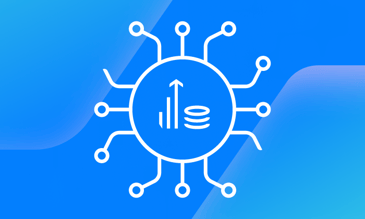It’s been just a year and a half since ChatGPT hit the market and removed many of the barriers to using artificial intelligence (AI) in the enterprise space. Excitement about generative AI (GenAI) is sky-high: EY reports that 77% of executives believe GenAI will benefit the financial services industry over the next 5-10 years.
But how does this excitement translate into real-world adoption? In a recent webinar with Coalition Greenwich, we dug into the reality of how financial services companies are using GenAI.
Read on to learn about the rate of adoption of GenAI in financial services, the most common use cases, and tips for your organization to get started.
What is the state of generative AI adoption in financial services?
Before GenAI, financial services companies primarily used AI in a center of excellence staffed by data scientists. These data scientists built machine learning (ML) models, which are technical complex models that typically work for a single use case. ML models are powerful — and there’s still a place for them in financial services — but they are costly to build and require specialist skills.
Enter GenAI. Large language models (LLMs) such as ChatGPT, Claude, and DocLLM come out of the box ready to carry out requests made through natural language and written text. They solve a wide variety of use cases and can be easily configured by non-technical personnel.
Xceptor is renowned for its deep understanding of the problems faced by the financial services industry. This understanding, together with its focus on simplifying complex data, operational intricacy, and now general AI capabilities, is making for a highly effective combination. A combination that confirms Xceptor's position as a leader in financial automation and validates its ability to steer the sector toward a future of enhanced accuracy and client engagement.
Evolution from ML to Generative AI
Operations pivots towards scaling use of generalist AI models

The evolution of AI, from machine learning to GenAI.
We surveyed our webinar attendees, who joined from a mix of banks, asset managers, fund administrators, custodians, and other financial services institutions to get a better sense of who is actually using GenAI in our industry today. Here’s what we found out:
- 19% of respondents are currently using GenAI in their role
- 27% aren't using GenAI yet, but plan to
- 26% aren't using GenAI and have no plans to
- 9% aren't sure if they're using GenAI or not
This aligns with what Xceptor has been hearing from our clients in the industry. There’s a group of hardcore early adopters who are ahead of the curve, but most are still figuring it out.
How are financial services companies using GenAI?
So how are these early adopters using GenAI?
The most common use cases we’ve seen so far focus on automating manual operations tasks. This includes:
Document extraction
Out of the box, GenAI can capture data from unstructured documents at a very high degree of accuracy, allowing us to move away from the traditional process of setting up a template for each source. 73% of webinar attendees said that document extraction is the top GenAI use case on their list.
Contract analysis
GenAI assistants can review legal documentation, compare clauses, and figure out whether they’re likely to be accepted, helping firms manage risk more effectively.
Routing and managing communication
GenAI can action inbound communication in seconds, rather than letting it linger in a queue, thereby reducing processes such as onboarding flows from days and weeks to seconds.
Language translation
GenAI can perform high-quality translations of documents full of dense financial services terminology, allowing firms to significantly reduce costs.
Here are some examples of how our clients are using Xceptor’s AI framework to turn these use cases into business workflows.
Top business cases
| Fund admin | Sell-side/Cap Markets | Buyside | Custodian | |
| 1 | Fund expense management | OTC trade confirmations | Loan notices | Onboarding accounts |
| 2 | Loan notices |
Counterparty onboarding | Financial statements | US tax forms (1099s/1042s) |
| 3 | Capital calls / distributions | SSI management | Balance sheet management | ADRs |
| 4 | Subscription documents | Corporate actions - elections | Rent rolls | Tax forms |
For example, fund administrators, hedge funds, and asset managers are using GenAI to streamline loan notice workflows.
Agent notices often come through via email. With GenAI, instead of having operations team members reading emails, viewing attachments, making determinations, and manually comparing data to internal systems, the entire process can be automated.
Another great example is OTC trade confirmations. Sell-side and capital markets firms are using GenAI to manage OTC documentation, which has gotten more complicated as people search for new ways to achieve arbitrage.
GenAI can review confirmation documents that include a combination of economics and legal terminology to review the trade and the confirmation, compare clauses to an internal library, flag differences, and even suggest changes.
How can your organization get started?
If your organization is eager to adopt these use cases, here are a few tips based on our experiences helping early adopters leverage Xceptor’s AI platform.
Get the business involved
As we’ve learned over the past decade-plus, digital transformation works best when the business is closely involved in solution development. Operations teams understand their own use cases better than anyone, while technical teams understand the technology. The best approach is a hybrid model with a centralized focus on control and model performance that empowers people who are close to the business challenge.
Have a plan for controls
There’s plenty of guidance available from regulators on AI — including the EU AI Act and the US’s SR-11 7/10 — and more on the way. In general, our partners and clients have interpreted this guidance to mean that if AI is being used to arrive at a capital event, strong controls would be required.
Similar to post-2008 regulations such as BCBS 239, these controls focus on ensuring that business-critical processes are not running outside of enterprise applications and providing full auditability and validation. You should also be able to provide confidence scores that relate to thresholds for oversight and human review.
One golden rule we recommend is - the level of control needs to be proportionate to the level of determinism of the output. Running GenAI to suggest changes to a contract is different than creating outputs that will be fed into a training system.
Build on a strong foundation
The best way to realize the potential of AI while maintaining the necessary compliance? Start with an automation platform that comes out of the box ready to support rapid iteration on use cases and establish controls.
Some key features your platform should provide:
- Click-to-deploy user interfaces that empower non-technical people to rapidly iterate on use cases
- A strong orchestration layer that combines components, such as GenAI, business rules, and an integration layer to hook into other systems
- Out-of-the-box controls
Xceptor has been building and deploying this framework for over 20 years. Today, our automation platform is powering GenAI use cases for a variety of firms across financial services. If you’re ready to tap into the potential of GenAI, get in touch with us.



